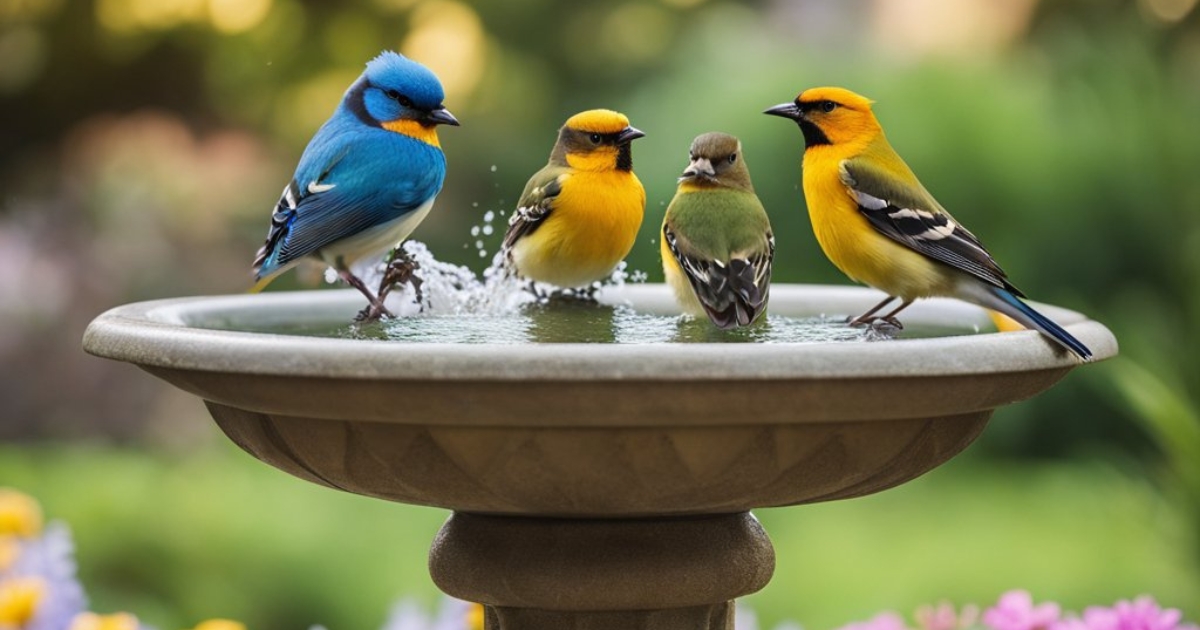There’s something truly special about having birds visit your yard. Their vibrant colors, melodic songs, and lively behaviors can bring a sense of wonder and joy to any outdoor space. While bird feeders are a common way to attract feathered friends, they’re not the only option. With a little creativity and effort, you can transform your yard into a welcoming oasis for birds without relying on traditional feeders.
The joy of attracting birds to your yard
Watching birds flit from branch to branch, forage for food, and raise their young is a delightful experience that connects us with nature. Their presence can add a sense of liveliness and beauty to your outdoor surroundings, making your yard feel more vibrant and alive.
The benefits of having birds around
Beyond the simple pleasure they bring, birds play crucial roles in our ecosystems. They help control insect populations, pollinate plants, and disperse seeds, contributing to a healthy and balanced environment. By attracting birds to your yard, you’re not only enhancing your own enjoyment but also supporting local biodiversity.
Why feeders are not always necessary
While bird feeders are a popular and effective way to attract birds, they require regular maintenance, can be messy, and may inadvertently encourage nuisance species or unwanted pests. By creating a natural, feeder-free environment, you can attract a diverse array of birds while minimizing some of the drawbacks associated with traditional feeders.
Creating a Bird-Friendly Habitat
The key to attracting birds without a feeder is to provide the essential elements they need to thrive: water, shelter, and food sources. By incorporating these elements into your yard, you’ll create an inviting and sustainable habitat that will naturally draw in a variety of bird species.
Providing water sources
Water is essential for birds, not only for drinking but also for bathing and preening. By offering water sources in your yard, you’ll make it a more attractive destination for feathered visitors.
Bird baths
A simple bird bath can be a fantastic addition to your yard. Look for models with a rough or textured surface to provide good traction for birds. Place the bath in a shaded area, near shrubs or trees, to offer protection from predators and direct sunlight.
Small ponds or fountains
If you have the space and resources, consider installing a small pond or fountain. The sound of moving water is particularly attractive to birds, and the water source will provide a reliable drinking and bathing spot. Just be sure to maintain proper depth and prevent stagnation.
Offering nesting sites
Birds need safe and secure places to build their nests and raise their young. By providing nesting sites in your yard, you’ll encourage more birds to take up residence and enjoy the benefits of your bird-friendly habitat year-round.
Birdhouses
Birdhouses are a classic way to offer nesting sites for certain species, like bluebirds, wrens, and chickadees. Be sure to research the specific requirements for the birds you hope to attract, as different species have preferences for entrance hole sizes, nest box dimensions, and placement.
Brush piles and dead trees
If you have the space, consider leaving some areas of your yard a little untidy. Brush piles, fallen logs, and dead trees can provide excellent nesting spots for many species of birds. Just be mindful of potential fire hazards and any local regulations regarding yard maintenance.
Planting native vegetation
One of the most effective ways to attract birds is to provide them with the natural food sources they’re adapted to. By incorporating native plants into your landscaping, you’ll not only create a more sustainable and low-maintenance yard but also offer a reliable food supply for your feathered visitors.
Berry-producing shrubs
Many bird species, such as robins, waxwings, and thrushes, rely heavily on berries as part of their diet. Plant native berry-producing shrubs like serviceberry, chokecherry, or elderberry to provide a natural source of food.
Seed-bearing plants
Finches, sparrows, and other seed-eating birds will flock to your yard if you offer a variety of seed-bearing plants. Native grasses, sunflowers, and coneflowers are all excellent choices that will self-seed and provide a steady supply of food.
Nectar-rich flowers
Hummingbirds and other nectar-feeding birds will be drawn to your yard if you plant nectar-rich flowers like trumpet vines, cardinal flowers, or bee balms. Be sure to choose native varieties suited to your local climate and conditions.
Encouraging Natural Food Sources
In addition to planting native vegetation, there are other ways to encourage natural food sources for birds in your yard. By embracing a slightly more relaxed approach to yard maintenance, you can create a more bird-friendly environment.
Leaving some areas of your yard untidy
While a perfectly manicured lawn and landscape may be aesthetically pleasing to some, it can be a barren environment for birds. Consider leaving some areas of your yard a little unkempt, with fallen leaves, twigs, and other organic matter left in place.
Allowing fallen fruits and seeds to remain
If you have fruit trees or other plants that produce edible seeds or fruits, resist the urge to immediately clean up after they drop. Leave some of these natural food sources on the ground for birds to forage on.
Embracing insect populations
Many bird species, particularly songbirds, rely heavily on insects as a crucial part of their diet, especially during the breeding season when they need to feed their young. By embracing and encouraging healthy insect populations in your yard, you’ll provide a valuable food source for your feathered friends.
Importance of insects for birds
Insects are an essential source of protein, fat, and other nutrients for birds. They’re particularly important for nestlings and fledglings, as the high protein content helps fuel their rapid growth and development.
Avoiding insecticides
To maintain a healthy insect population, it’s important to avoid the use of broad-spectrum insecticides in your yard. Instead, consider more targeted and eco-friendly pest control methods, or simply learn to tolerate some insect presence as a necessary part of a balanced ecosystem.
Creating a Safe Environment
While providing food, water, and shelter is crucial for attracting birds, it’s also important to ensure your yard is a safe haven for your feathered visitors. By minimizing potential hazards and offering appropriate cover, you’ll create a welcoming and secure environment.
Minimizing potential hazards
Certain features or elements in your yard can pose risks to birds, so it’s important to address these potential hazards to keep your avian guests safe.
Windows
Large, reflective windows can be a significant danger to birds, as they may mistake the reflection for an open pathway and collide with the glass. Consider applying window decals or other deterrents to make the glass more visible to birds.
Outdoor cats and other predators
While it’s natural for birds to face predation from certain animals, domestic cats and other introduced predators can pose a significant threat. If possible, keep cats indoors or create enclosed outdoor spaces to protect your yard’s bird population.
Providing cover and shelter
Birds need safe places to rest, hide from predators, and seek shelter from inclement weather. By incorporating dense shrubs, evergreen trees, and other forms of cover into your yard, you’ll create a sense of security and protection for your feathered visitors.
Dense shrubs and trees
Thick, dense shrubs and evergreen trees provide excellent cover for birds. They offer protection from wind, rain, and potential predators, as well as safe nesting sites and roosting spots.
Brush piles or rock piles
In addition to serving as potential nesting sites, brush piles and rock piles can also offer valuable cover and shelter for birds. These natural structures provide hiding places and protection from the elements.
Supplementing with Natural Foods
While creating a bird-friendly habitat and encouraging natural food sources should be the primary focus, there’s nothing wrong with occasionally supplementing with additional food offerings. Just be sure to choose options that are safe, healthy, and appropriate for the birds you hope to attract.
Offering fruit and nuts
Many bird species, such as jays, woodpeckers, and mockingbirds, enjoy a variety of fruits and nuts. Consider placing small amounts of fresh or dried fruits and unsalted nuts in appropriate locations around your yard.
Providing suet or seed cakes
During the colder months or periods of food scarcity, offering suet or seed cakes can be a welcome supplement for birds. These high-energy foods can help sustain birds when natural food sources are scarce.
Growing a bird-friendly garden
If you have space for a vegetable or fruit garden, consider planting a variety of crops that can provide food for birds. Sunflowers, millet, and other seed-bearing plants are excellent choices, as are fruits like raspberries, strawberries, and blueberries.
Patience and Observation
Transforming your yard into a bird-friendly oasis without feeders takes time and patience. It may take weeks or even months for birds to discover the new habitat you’ve created and begin taking advantage of the resources you’ve provided.
Allowing time for birds to discover your yard
Don’t be discouraged if you don’t see many birds right away. As long as you’ve provided the essential elements they need, they’ll eventually find your yard and start to make it their home.
Watching and enjoying the bird visitors
One of the greatest rewards of creating a bird-friendly yard is the opportunity to observe and enjoy the various species that visit. Set aside time to sit quietly and watch for their behaviors, listen to their songs, and appreciate the beauty and wonder they bring to your outdoor space.
People Also Read:
Conclusion
Attracting birds to your yard without the use of traditional feeders is not only possible but can be a rewarding and sustainable approach to enjoying the company of our feathered friends. By creating a bird-friendly habitat with water sources, nesting sites, native vegetation, and safe cover, you’ll provide the essential elements birds need to thrive.
Remember, the key is to be patient and allow time for the birds to discover the oasis you’ve created. Once they do, you’ll be able to enjoy the beauty, songs, and fascinating behaviors of a diverse array of species right in your own backyard.
So why not take the first step today? Start planning your bird-friendly landscape, and soon you’ll be welcoming a whole new world of winged visitors to your little slice of nature.
FAQs
Q: Won’t birds just go to my neighbors’ yards if they have feeders?
A: While birds may visit feeders in other yards, creating a well-rounded habitat in your own yard will encourage them to stick around and potentially even nest there. A diverse array of food sources, water, and shelter will make your yard an appealing destination.
Q: How long does it take for birds to find a new bird-friendly yard?
A: It can take weeks or even months for birds to discover and start taking advantage of a newly created bird-friendly habitat. Be patient and allow time for word to spread among the local bird population.
Q: Are there certain plants that are better for attracting specific types of birds?
A: Yes, different bird species have preferences for certain types of plants. For example, hummingbirds are drawn to nectar-rich flowers, while seed-eating birds prefer plants that produce edible seeds or grains. Research the types of birds you hope to attract and choose plants accordingly.
Q: Can I still put out feeders occasionally even if I’m trying to attract birds without them?
A: Absolutely! While the goal is to create a self-sustaining, feeder-free environment, there’s nothing wrong with occasionally supplementing with feeders, especially during times of food scarcity or harsh weather conditions.
Q: What should I do if I notice signs of predators like outdoor cats or hawks in my yard?
A: Take steps to create a safe environment for the birds by deterring or excluding potential predators. This may include keeping cats indoors, installing hawk deterrents, or providing dense cover and shelter for the birds to seek refuge.

